Embarking on the journey of fermenting foods can be both exciting and daunting for beginners. The world of fermentation is rich with tradition, flavor, and health benefits, but where does one start?
Whether you’re eager to dive into the art of fermenting vegetables or intrigued by the idea of crafting your own probiotic-rich foods at home, there’s a wealth of knowledge waiting to be explored.
In this guide, we’ll introduce you to some essential books that cater specifically to beginners in the realm of fermentation. From straightforward guides with easy-to-follow recipes to comprehensive volumes delving deep into the science and cultural significance of fermentation, these books offer a diverse array of insights and techniques to help you kickstart your fermentation journey.
Let’s dive in and discover the essential books that will empower you to ferment with confidence and creativity, transforming simple ingredients into complex flavors and nourishing probiotic-rich foods right in your own kitchen.
Check out some of our other articles on fermentation:
– 28 Easy Fermentation Recipes
– Pickling vs. Fermenting
– 19 Sourdough Discard Recipes
– Intro to At-Home Fermenting
Fermented Vegetables by Kirsten and Christopher Shockey
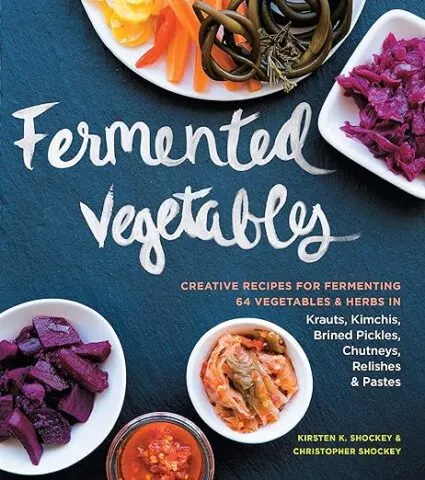
Fermented Vegetables by Kirsten and Christopher Shockey is the best fermentation book for beginners who want to jump right in. The best way to learn is to do, right?
This easy-to-follow comprehensive guide presents more than 120 recipes for fermenting 64 different vegetables and herbs. Learn the basics of making kimchi, sauerkraut, and pickles, and then refine your technique as you expand your repertoire to include curried golden beets, pickled green coriander, and carrot kraut.
With a variety of creative and healthy recipes, many of which can be made in batches as small as one pint, you’ll enjoy this fun and delicious way to preserve and eat your vegetables.
Fermentation for Beginners: The Step-by-Step Guide to Fermentation and Probiotic Foods
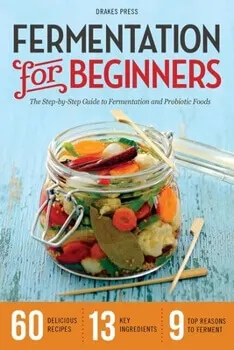
With straightforward guides, delicious recipes, and step-by-step instructions, Fermentation for Beginners takes the stress out of at-home fermentation.
Fermentation for Beginners expertly outlines the materials and ingredients you will need. Presented in a no-nonsense approach that will put you at ease when starting the fermenting of foods in your own home.
This book will show you how and why to ferment your own foods, with:
- 60 Recipes providing step-by-step instructions for safe and effective fermentation
- Helpful Tips covering the ingredients and equipment you need to start fermenting at home
- An Overview explaining the science behind fermentation
Fermentation recipes include Garlic Dill Pickles, Pear Chutney, Greek-style yogurt, Tempeh, Sourdough Baguettes, Corned Beef, Red Wine Vinegar, Basic Beer, Basic Wine, and much more!
With the right combination of microbes and a little skill, Fermentation for Beginners will give you all the tools you need to start fermenting your own foods right away.
The Art of Fermentation by Sandor Ellix Katz
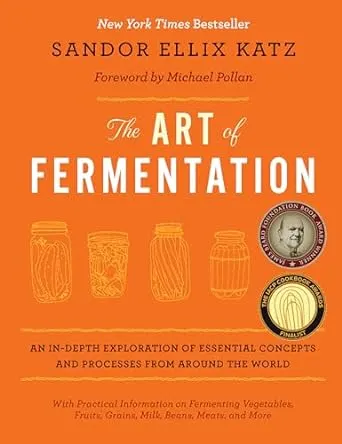
If you plan on diving deep into fermentation and want to have an incredible resource to keep on your shelves, this is the book you need.
The Art of Fermentation is the most comprehensive guide to do-it-yourself home fermentation ever published. Sandor Katz presents the concepts and processes behind fermentation in ways that are simple enough to guide a reader through their first experience making sauerkraut or yogurt, and in-depth enough to provide greater understanding and insight for experienced practitioners.
While Katz expertly contextualizes fermentation in terms of biological and cultural evolution, health and nutrition, and even economics, this is primarily a compendium of practical information—how the processes work; parameters for safety; techniques for effective preservation; troubleshooting; and more.
With two-color illustrations and extended resources, this book provides essential wisdom for cooks, homesteaders, farmers, gleaners, foragers, and food lovers of any kind who want to develop a deeper understanding and appreciation for arguably the oldest form of food preservation, and part of the roots of culture itself.
Readers will find detailed information on fermenting vegetables; sugars into alcohol (meads, wines, and ciders); sour tonic beverages; milk; grains and starchy tubers; beers (and other grain-based alcoholic beverages); beans; seeds; nuts; fish; meat; and eggs, as well as growing mold cultures, using fermentation in agriculture, art, and energy production, and considerations for commercial enterprises.
The Joy of Pickling by Linda Ziedrich
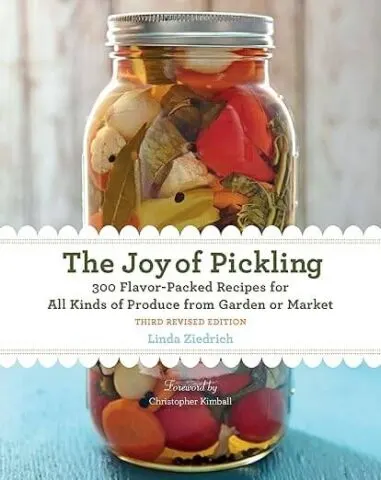
The Joy of Pickling
Putting up pickles is a time-honored technique for preserving the harvest and getting the most out of fresh produce, whether you grow it yourself or purchase it at the supermarket or farmers market. But pickling isn’t just about preserving: It’s a way to create mouthwatering condiments and side dishes that add endless variety and loads of big, vibrant flavors to the table.
Making these salty, sour, sweet, and tangy treats isn’t hard, as long as you have this authoritative and user-friendly volume to guide you. This new edition includes 50 brand-new recipes, many focused on the latest trend in pickling: fermentation. It also includes:
- Pickles from all over the globe, from down-home American favorites to adventuresome new ideas from Asia, the Middle East, and Europe
- Recipes for canned and put-up pickles and also for super-easy quick pickles for the fridge or freezer
- New techniques for preventing yeast and mold growths on fermented pickles
- Recipes for using pickled produce in chutneys, salsas, relishes, and more
- Expert safety guidance and tips
From Lower East Side Full-Sour Dills to Cabbage and Radish Kimchi, Pickled Whole Watermelons to Quick Pickled Baby Corn, the 300 recipes in The Joy of Pickling make the harvest last, deliciously and freshly, all year round.
The Noma Guide to Fermentation (Foundations of Flavor)
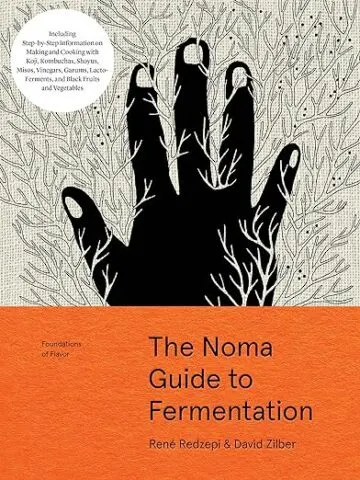
At Noma—four times named the world’s best restaurant—every dish includes some form of fermentation, whether it’s a bright hit of vinegar, a deeply savory miso, an electrifying drop of garum, or the sweet intensity of black garlic. Fermentation is one of the foundations behind Noma’s extraordinary flavor profiles.
Now René Redzepi, chef and co-owner of Noma, and David Zilber, the chef who runs the restaurant’s acclaimed fermentation lab, share never-before-revealed techniques to creating Noma’s extensive pantry of ferments. And they do so with a book conceived specifically to share their knowledge and techniques with home cooks.
With more than 500 step-by-step photographs and illustrations, and with every recipe approachably written and meticulously tested, The Noma Guide to Fermentation takes readers far beyond the typical kimchi and sauerkraut to include koji, kombuchas, shoyus, misos, lacto-ferments, vinegars, garums, and black fruits and vegetables. And—perhaps even more important—it shows how to use these game-changing pantry ingredients in more than 100 original recipes.
Wild Fermentation by Sandor Ellix Katz
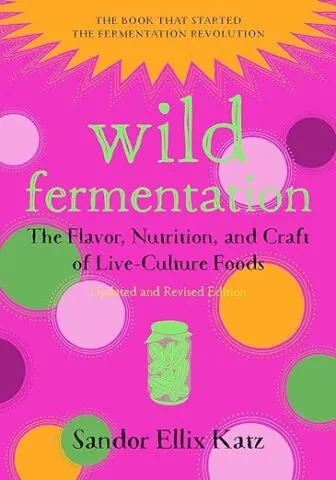
Sandor Ellix Katz, a self-described fermentation revivalist, is perhaps best known simply as Sandorkraut, which describes his joyful and demystifying approach to making and eating fermented foods, the health benefits of which have helped launch a nutrition-based food revolution.
Since its original publication, and aided by Katz’s engaging and fervent workshop presentations, Wild Fermentation has inspired people to turn their kitchens into food labs: fermenting vegetables into sauerkraut, milk into cheese or yogurt, grains into sourdough bread, and much more.
This updated and revised edition, now with full color photos throughout, is sure to introduce a whole new generation to the flavors and health benefits of fermented foods. It features many brand-new recipes, including:
- Strawberry Kvass
- African Sorghum Beer
- Infinite Buckwheat Bread
- And many more!
DIY Fermentation: Over 100 Step-By-Step Home Fermentation Recipes
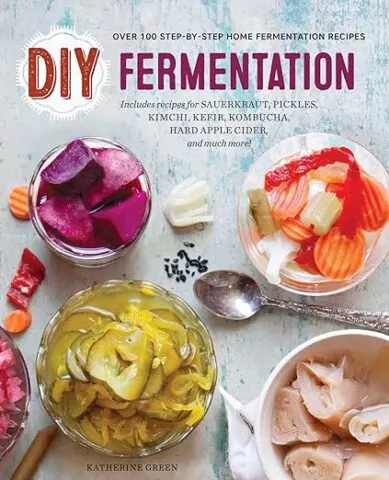
Fermentation has given us some of the food world’s most treasured delights, and with DIY Fermentation, making delicious probiotic foods in your own kitchen has never been easier. Accessible overviews of fundamental fermentation techniques and step-by-step recipes provide the basic skills you will turn to again and again as you experiment with nourishing ferments at home.
Work your way through a wide range of do-it-yourself fermentation projects with:
- 100+ recipes to make your own sauerkraut, kimchi, pickles, kefir, yogurt, vinegar, kombucha, hard apple cider, and more
- Recipes ranging from beginner to advanced to put your skills to the test
- Detailed troubleshooting guides to ensure fermentation success
- Insider tips and anecdotes from fermentation experts
- Step-by-step illustrations to stay on track
- A bonus chapter integrating homemade ferments into everyday cooking
Enjoy all the health benefits and delicious flavors of naturally fermented vegetables, fruits, dairy, beverages, breads, condiments, and much more with this invaluable guide to unleash your inner DIYer and master your fermentation skills.
Wildcrafted Fermentation by Pascal Baudar
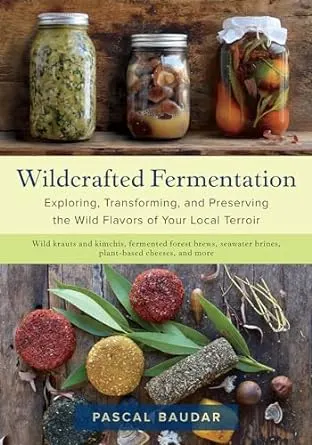
In Wildcrafted Fermentation, Pascal Baudar describes in detail and through step-by-step color photos how to create rich flavorful ferments:
- At home
- From the wild plants in your local landscape
- From the cultivated plants in your garden
From sauerkrauts and kimchis to savory pastes, hot sauces, and dehydrated spice blends, Baudar includes more than 100 easy-to-follow, plant-based recipes to inspire even the most jaded palate. The step-by-step photos illustrate foraging, preparation, and fermentation techniques for both wild and cultivated plants that will change your relationship to the edible landscape and give you the confidence to succeed like a pro.
So much more than a cookbook, Wildcrafted Fermentation offers a deeply rewarding way to reconnect with nature through the greens, stems, roots, berries, fruits, and seeds of your local terroir. Adventurous and creative, this cookbook will help you rewild your probiotic palate and “create a cuisine unique to you and your environment.”

